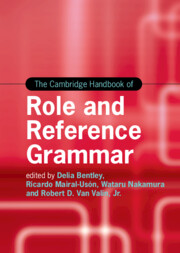Book contents
- The Cambridge Handbook of Role and Reference Grammar
- Cambridge Handbooks in Language and Linguistics
- The Cambridge Handbook of Role and Reference Grammar
- Copyright page
- Dedication
- Contents
- Figures
- Tables
- Contributors
- Pedagogical Guide to The Cambridge Handbook of Role and Reference Grammar
- Introduction
- Part One Overview
- Part Two Topics in RRG: Simple Sentences
- Part Three Topics in RRG: Complex Sentences
- 13 The Structure and Semantics of Complex Sentences
- 14 Linking Syntax and Semantics in Adverbial (Adjoined) Clauses
- 15 Cleft Sentences and Relative Clauses
- 16 Extraction Restrictions in Complex Sentences
- Part Four Applications of RRG
- Part Five Grammatical Sketches
- Index
- References
13 - The Structure and Semantics of Complex Sentences
from Part Three - Topics in RRG: Complex Sentences
Published online by Cambridge University Press: 08 June 2023
- The Cambridge Handbook of Role and Reference Grammar
- Cambridge Handbooks in Language and Linguistics
- The Cambridge Handbook of Role and Reference Grammar
- Copyright page
- Dedication
- Contents
- Figures
- Tables
- Contributors
- Pedagogical Guide to The Cambridge Handbook of Role and Reference Grammar
- Introduction
- Part One Overview
- Part Two Topics in RRG: Simple Sentences
- Part Three Topics in RRG: Complex Sentences
- 13 The Structure and Semantics of Complex Sentences
- 14 Linking Syntax and Semantics in Adverbial (Adjoined) Clauses
- 15 Cleft Sentences and Relative Clauses
- 16 Extraction Restrictions in Complex Sentences
- Part Four Applications of RRG
- Part Five Grammatical Sketches
- Index
- References
Summary
This chapter offers an in-depth treatment of clause linkage and complex sentences in RRG. First, it discusses and exemplifies each nexus–juncture type, adducing evidence from a wide range of languages. Then, it introduces the notion of syntactic and semantic cohesiveness in clause linkage and makes relevant generalizations and predictions.
Keywords
- Type
- Chapter
- Information
- The Cambridge Handbook of Role and Reference Grammar , pp. 525 - 556Publisher: Cambridge University PressPrint publication year: 2023
References
- 1
- Cited by



